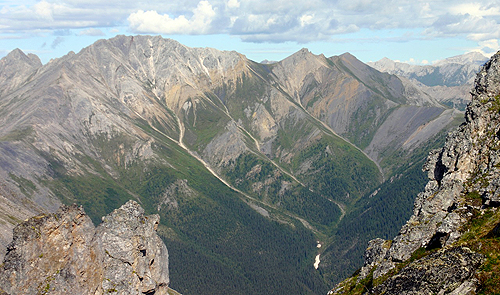Late Proterozoic Stratigraphy of Yukon and its Record of Earth System Evolution
 The exceptionally preserved Proterozoic stratigraphy in the Yukon and Northwest Territories records the tectonic evolution of ancestral North America spanning the break-up of the supercontinent Rodinia. Formerly contiguous sedimentary sequences should be found on the margins of the continental fragments that rifted apart from northern and western Canada (Australia, South China?) from about 850 to 550 million years ago. Together, these rocks bear witness to multiple glacial epochs, at least two of which were global in extent, and to the tumultuous transition to a fully oxygenated environment that supported the origin and diversification of animal life. Current understanding of these events suggests that the complex evolution of the Neoproterozoic Earth system reflects interconnections between tectonics, global climate, the biosphere, and ocean chemistry. The PROPS group is working with diverse collaborations on a multidisciplinary project to establish and interpret 1) the timing and nature of northwestern North America's break-up from the supercontinent Rodinia, 2) the influence of rifting and associated magmatism on Neoproterozoic climate and marine geochemistry, and 3) the tempo of important biogeochemical and biospheric changes and their interconnection with tectonic and climatic events.
The exceptionally preserved Proterozoic stratigraphy in the Yukon and Northwest Territories records the tectonic evolution of ancestral North America spanning the break-up of the supercontinent Rodinia. Formerly contiguous sedimentary sequences should be found on the margins of the continental fragments that rifted apart from northern and western Canada (Australia, South China?) from about 850 to 550 million years ago. Together, these rocks bear witness to multiple glacial epochs, at least two of which were global in extent, and to the tumultuous transition to a fully oxygenated environment that supported the origin and diversification of animal life. Current understanding of these events suggests that the complex evolution of the Neoproterozoic Earth system reflects interconnections between tectonics, global climate, the biosphere, and ocean chemistry. The PROPS group is working with diverse collaborations on a multidisciplinary project to establish and interpret 1) the timing and nature of northwestern North America's break-up from the supercontinent Rodinia, 2) the influence of rifting and associated magmatism on Neoproterozoic climate and marine geochemistry, and 3) the tempo of important biogeochemical and biospheric changes and their interconnection with tectonic and climatic events.
This project has been supported by NSERC, the Yukon Geological Survey, the American Chemical Society (Petroleum Research Fund), and Natural Resources Canada GEM2 and the Polar Continental Shelf Program.